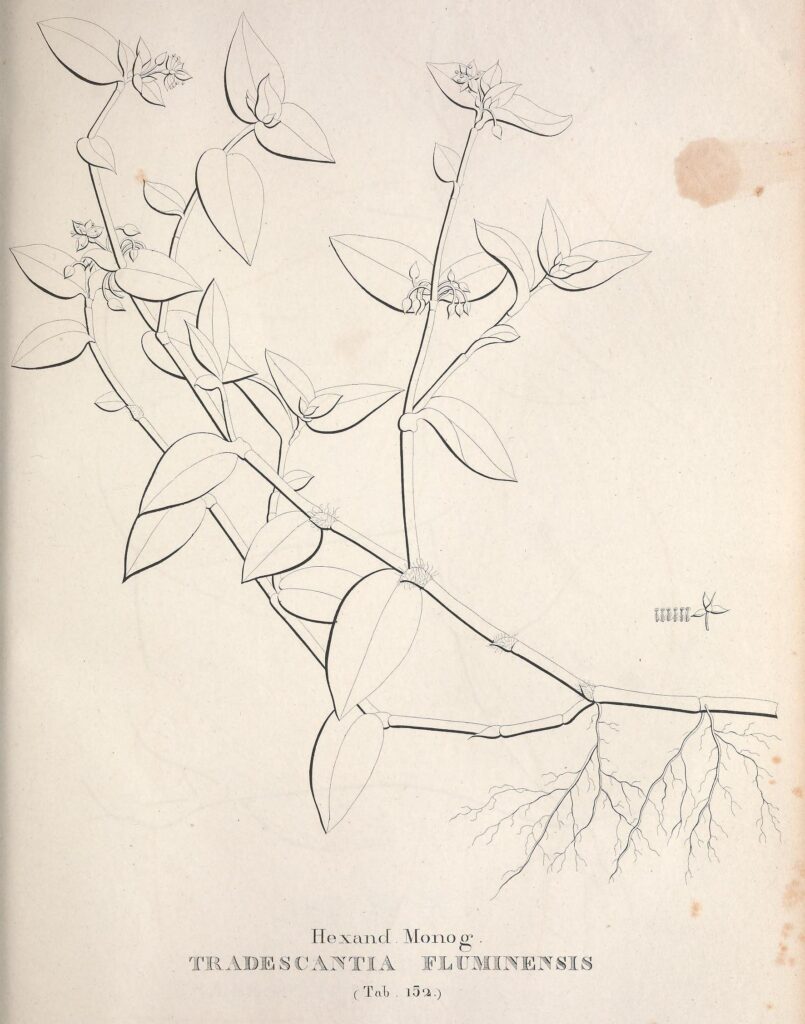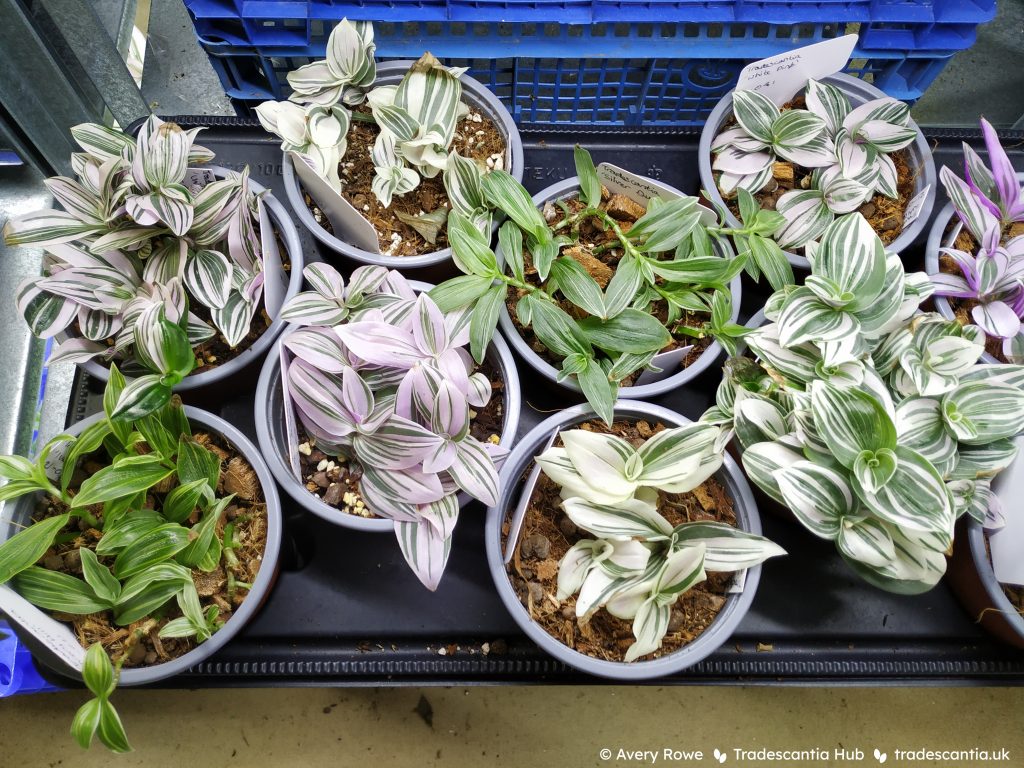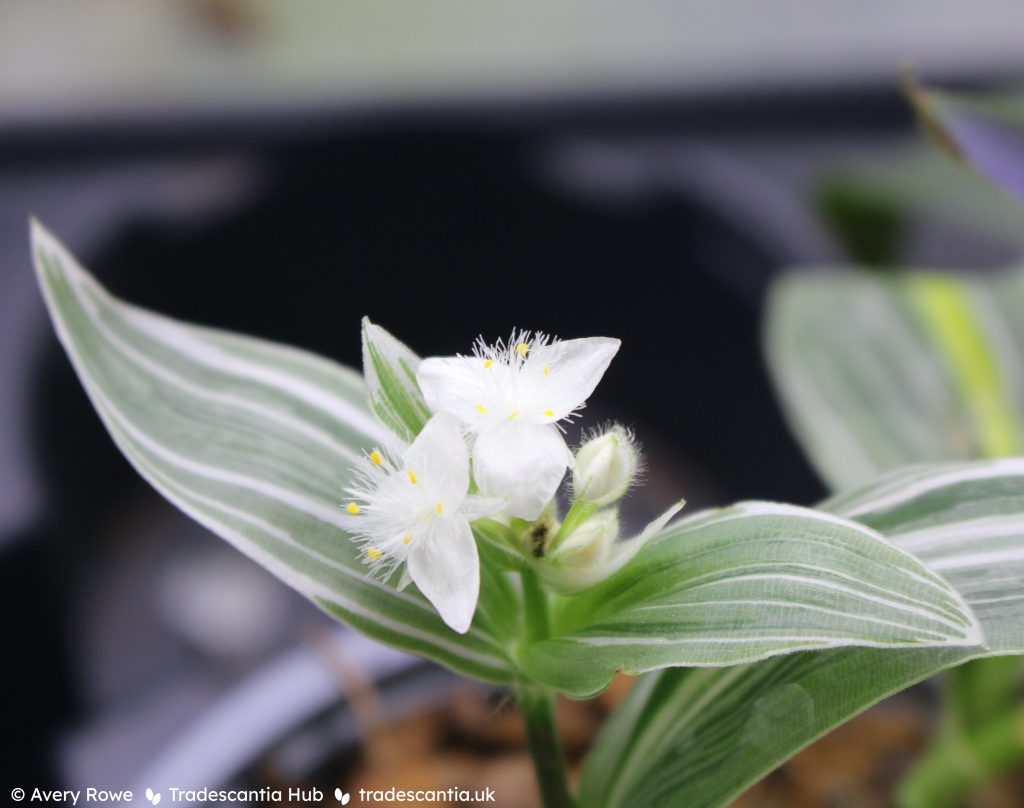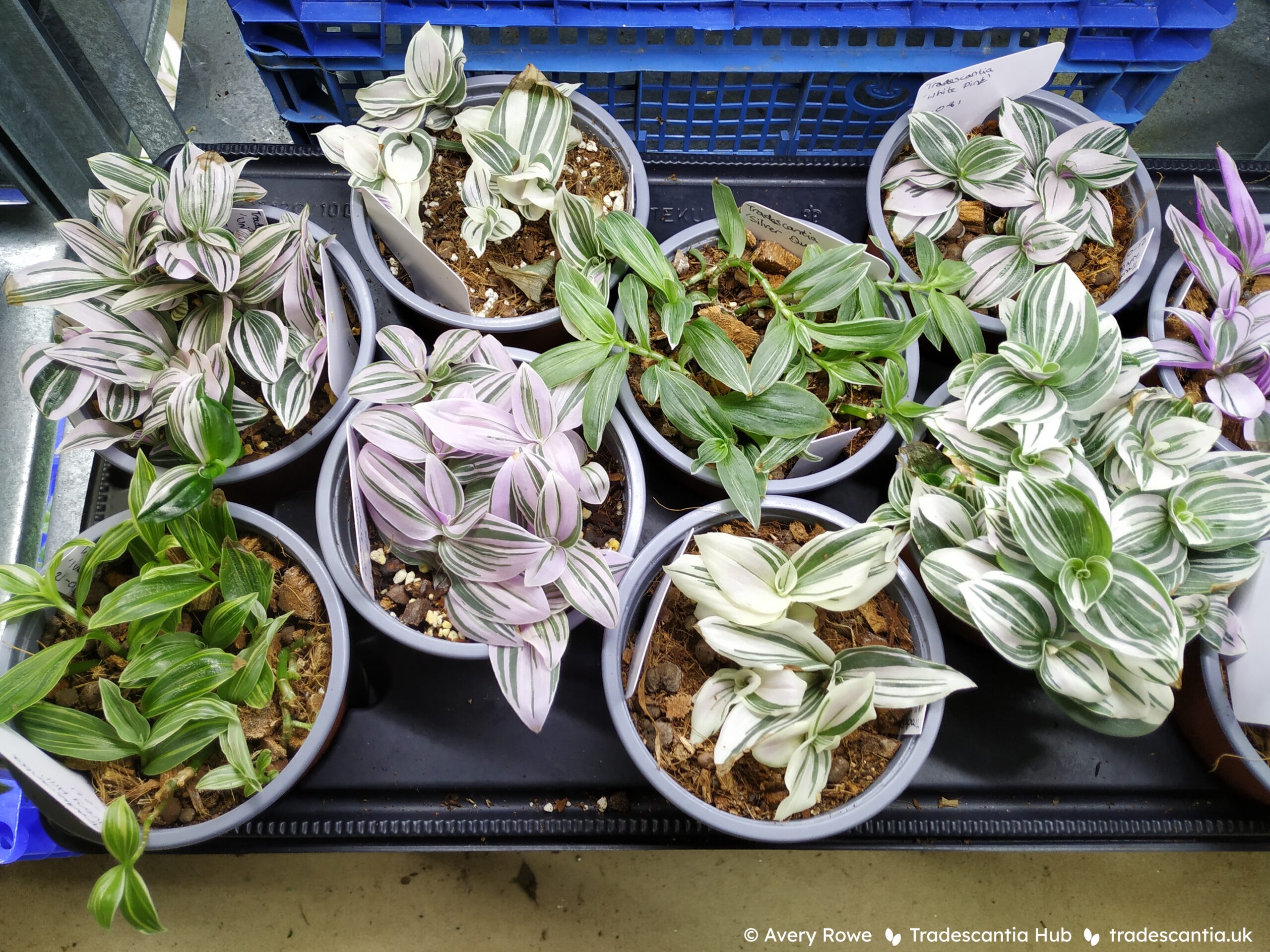Skip to: Botanical history // Horticultural use // Correct use // Future // References
Throughout history this name has been used in many different ways. There’s a lot of confusion and uncertainty over what plants it really refers to, or whether it should be used at all. This article will explain some of the history, the ways it’s currently used, and what’s scientifically accepted today.
The botanical history of Tradescantia albiflora
The name Tradescantia albiflora was first published in 1843 by Karl Kunth. In Latin (as all botanical descriptions used to be), he described a new species of plant with creeping stems, hairless leaves, and white flowers. Its native origins were unknown, because the plant he described was found in cultivation at the royal botanic garden of Berlin.
Earlier that century, José Vellozo published a description of a plant he named Tradescantia fluminensis (Vellozo, 1825). There’s a very brief description of a creeping plant, and an associated drawing. He observed wild plants in the area of Rio de Janeiro, and described the species as occuring on river banks and moist places.

So, we have two separate published descriptions, seemingly of two separate species. But in the time since these descriptions were published, other botanists have studied them and concluded that they don’t refer to distinct species. Since at least the 1980s (Hunt, 1980), scientists have been agreed that T. albiflora and T. fluminensis are actually names for the same plant.
The rules of botanical names say that, when two species turn out to be the same, whichever name was published first is correct. T. fluminensis was published first, so that means it’s the correct name for the species. The name T. albiflora is now botanically considered a synonym for T. fluminensis. It’s just an outdated name, and it shouldn’t be used any more because it’s not an accepted species.
It can be difficult for anyone – even the most dedicated botanists – to keep perfectly up to date with which names are correct and accepted. I defer to the Plants of the World Online, which is a database maintained by the Royal Botanic Gardens, Kew (a world-leading botanical authority). They keep track of which names are accepted, and which are considered synonyms or otherwise invalid. We can check the entries for T. fluminensis and T. albiflora, to confirm that one is correct and the other is a synonym.
How gardeners use the name Tradescantia albiflora
Like in many cases, the use of this name in horticulture has been much less precise or organised. There are several closely-related species which are common in cultivation – T. fluminensis, T. cerinthoides, T. mundula, and to a lesser extent T. crassula and possibly others. These can be difficult to distinguish unless they’re flowering (which isn’t always common), and it’s quite likely that some cultivated plants are now hybrids between multiple species.

But most growers and gardeners don’t actually care about those details very much. So historically, it has been common to use the name Tradescantia albiflora to describe pretty much any creeping tropical tradescantia. They all have more or less the same care requirements, so lots of people don’t see much need to distinguish between them anyway.
In the last few years, the correct species has been figured out for a few of these cultivars – for example, ‘Nanouk’ is actually T. cerinthoides, even though it was originally labelled as T. fluminensis or T. albiflora. But there are still a number of cultivars which are only ever labelled as T. albiflora, and that don’t seem to clearly match any valid species.
How we should use the name “albiflora”
In general, we shouldn’t. The name Tradescantia albiflora is outdated and no longer valid. Continuing to use it to refer to T. fluminensis would be unhelpful and pointless, while continuing to use it to refer to an ill-defined group of unknown hybrids is unhelpful and actively misleading!
Instead when we refer to cultivars in this group, the best thing to do is write just the genus name and no species. For example, one of the oldest of these cultivars is called ‘Albovittata’. Some people write Tradescantia fluminensis ‘Albovittata’, or Tradescantia albiflora ‘Albovittata’, but neither of these is right. The plant doesn’t fit the species Tradescantia fluminensis, and it’s just as inaccurate to use the outdated name Tradescantia albiflora.
The right way to name it is Tradescantia ‘Albovittata’. It’s less precise, but avoids any misleading information.

There’s currently no good, clear and accurate way of referring to these cultivars as a set. I use the term “albiflora group” for now, because it’s familiar and recognisable. But it’s not strictly a valid name for a cultivar group, because it’s been used for another species.
Because of the lack of information about these plants, even the boundaries of the vague “albiflora group” of cultivars is not well-defined. Most of the cultivars grouped together have certain things in common – white flowers, a fairly compact and branching growth habit, variegated pink or white leaves.
But there are also exceptions. There are several plain-green cultivars (which are likely to be sports from the variegated types). The old ‘Albovittata’ has much longer stems than the more modern cultivars. The very new Tradescantia SWEETNESS (‘EC TRAD 2106’) has a similar growth habit and leaves but is very small compared to others in the group.
We can’t conclusively say whether or not any particular plant belongs to the “albiflora group”, because we don’t actually know what the group is. Different people use it in different ways, and there’s no universally-agreed definition.
The future of the group
I’m very pleased to share that me and my colleagues, Dr Adrian Slater and Dr Tiziana Sgamma from De Montfort University, have been given some funding by the Stanley Smith Horticultural Trust for genetic research on this group of plants. We plan to conduct DNA barcoding work to try and determine the species or hybrid origins of the different cultivars, and find out how they all relate to one another. This research will take some time, but hopefully once it’s complete we’ll be able to make some sense of this confusing group at last.
When we have more information from our research, it may be useful to establish a formal cultivar group name and definition to classify these plants. For that to happen, there will need to be some careful decisions about how exactly the group is defined (which plants are ‘in’ and which are ‘out’), as well as a new valid name to use. If you have suggestions for a new name (perhaps something relating to a person or place associated with this group of cultivars?), please get in touch!
Update (9th Sep 2022)
This group of cultivars now has a valid name – the Tradescantia Continental Group! The group has been defined to include all the chunky uniformly-variegated cultivars in the Austrotradescantia subgenus, as well as plain green reverted sports. Thanks to Helen Winnington for suggesting the name, inspired by the fact many of these cultivars seemed to originate from continental Europe.
Found this article useful?
If you want more great resources like this, you can help me keep making them with a regular payment on Patreon.
References
Vellozo, J. M. C. (1825). Florae fluminensis, seu, Descriptionum plantarum praefectura Fluminensi sponte mascentium liber primus ad systema sexuale concinnatus. Text: https://www.biodiversitylibrary.org/page/637849#page/147/mode/1up . Illustrations: https://www.biodiversitylibrary.org/item/139833#page/309/mode/1up.
Kunth, K. S. (1843). Enumeratio plantarum omnium hucusque cognitarum : secundum familias naturales disposita, adjectis characteribus, differentiis et synonymis. https://www.biodiversitylibrary.org/page/42518030#page%2F94%2Fmode%2F1up=.
Hunt, D. R. (1980). Sections and Series in Tradescantia: American Commelinaceae: IX. Kew Bulletin, 35(2), 437–442. https://doi.org/10.2307/4114596.


4 replies on “What is Tradescantia albiflora?”
Great article please keep up your good work.Tradescantia Lover
Thank you so much!
Thanks for the article!
Could you specify which one then bottom one, third from left is? I am after that one bur can’t find rhe exact name to look for one. Thanks!
The photo is pretty old now, so I’m not 100% sure! But I think that one is probably ‘Angel Wings’, which is sometimes just labelled as “albiflora variegata” (unhelpful since that also refers to the entire group…) or “white clone”.